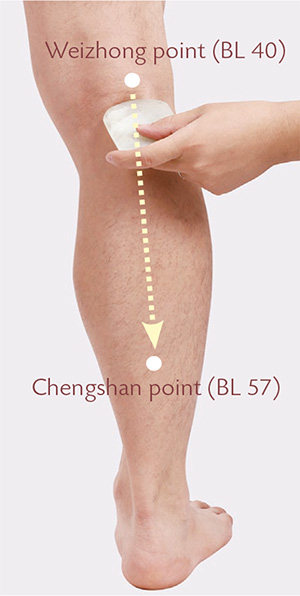Use Gua Sha to Expel Wind-Damp and Cold Toxin to Get Rid of Joint Problems
Wind, damp and the cold are all malignant elements in the Mother Nature. Various problems will occur if they intrude the human body, particularly the joints, inducing joint pain. Through smoothing vital energy and blood in main collateral channels, scraping therapy can expel the pathogenic wind, damp, and cold from the human body, thus eliminating joint pain.
Cervical Spondylosis
This refers to a series of pathological changes gradually taking place in cervical vertebra due to certain trauma and damage. It is generally marked by pain or numbness with pain in the neck, shoulders and arms, the upper part of shoulders, the upper chest and upper limbs, restricting neck movement. The pain often becomes worse because of fatigue or the cold. The area of pain is closely associated with the passage of channels. Scraping therapy produces an obvious effect on easing and reducing the symptom.
Apart from receiving scraping therapy, the person concerned should move the neck more and do neck exercise if working at the desk for a long time, which is conducive to easing the symptom or preventing the recurrence of pain. The patient with cervical spondylosis should pay attention to keeping the neck warm in daily life and setting the pillow at a height no more than 10 centimeters.
There are five kinds of cervical spondylosis, i.e., cervical spondylotic radiculopathy, cervical spondylotic myelopathy, sympathetic cervical spondylosis, vertebral artery type of cervical spondylosis and mixed type of cervical spondylosis. Among them, cervical spondylotic radiculopathy (it is mainly marked by weakness and heaviness in lower limbs and difficulty in walk) should not be directly scraped, but acupoints of other related areas can be scraped.
Recommended Procedures
1. Reflection Areas of the Cervical
Vertebra and the Neck-Shoulder on the Hand Back
Method: Use the vertical-pressing and kneading to press and knead the areas and look for the points of pain to be pressed and kneaded emphatically.

2. Reflection Area of the Cervical Vertebra on the Medial Foot
Method: Apply the scraping oil to the arch of the foot and use the surface-scraping to scrape the reflection area on the rear of the medial foot on the inside of the big toe. Scrape the points with nodules and pain emphatically and slowly.

3. Fengfu Point, Shenzhu Point, Tianzhu Point, Dazhu Point, Fengchi Point and Jianjing Point
Method: Use the surface-scraping to scrape from Fengfu point to Shenzhu point of Du Meridian in the rear of the neck in separate sections from up to down. Use two corners of the scraping plate to scrape from Tianzhu point to Dazhu point of Bladder Meridian on both sides of the neck in separate sections from up to down. Use the single-angle scraping to scrape Fengchi point. Use the surface-scraping to scrape from Fengchi point to Jianjing point on both sides in separate sections, with stress on Jianjing point. Scrape the areas with pain, nodules, muscle tension or stiffness emphatically.

4. Waiguan Point, Zhongzhu Point, Yanglingquan Point and Xuanzhong Point
Method: Use the surface-scraping to scrape Waiguan point on upper limbs from up to down. Use the vertical-pressing and kneading to press and knead Zhongzhu point on the hand back. Use the surface-scraping to scrape from Yanglingquan point to Xuanzhong point from up to down.
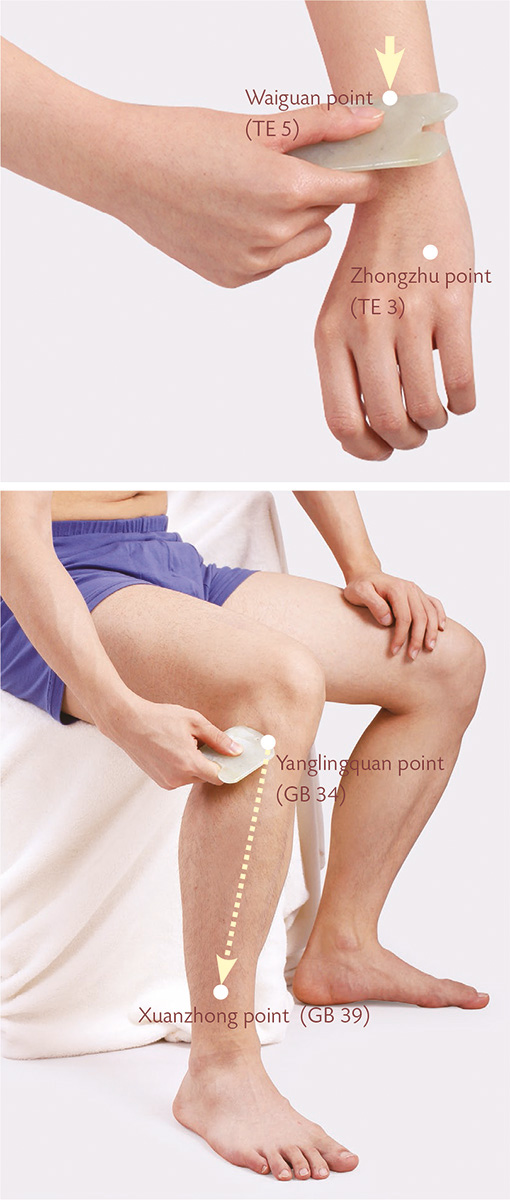
This refers to a chronic and retrogressive pathological change in joint capsules and surrounding soft tissues, mainly marked by pain around shoulders and functional obstruction of physical movement. It is mostly caused by chronic strains, trauma of tendons, intrusion of the cold-damp, leading to the blockage of vital energy and blood circulation and the passage of main and collateral channels. The pain of shoulder joints is worse at night, in cloudy and damp weather or after labor work. Scraping therapy can smooth the vital energy, blood and meridians around the shoulders, easing pain.
Reinforcing the movement of shoulder joints can release the adhesion of these joints, avoid the contraction of muscles and promote the restoration of normal joint functions. The patient of shoulder periarthritis should pay attention to protecting shoulders in daily life and covering shoulders in sleep. The patient of stubborn shoulder periarthritis failing to be cured for a long time should be mindful of illness in endocrine system, such as diabetes, requiring further diagnosis. Scraping should be done gently when it comes to shoulder periarthritis caused by trauma.

1. Quchi Point, Waiguan Point and Zhongzhu Point
Method: Use the single-angle scraping to scrape Quchi point and Waiguan point from up to down. Use the vertical-pressing and kneading to press and knead Zhongzhu point.

2. Jianjing Point and Naoshu Point
Method: Use the surface-scraping to scrape from Jianjing point to Naoshu point from inside to outside, with stress on areas with pain or nodules.

3. Jianliao Point and Bi, nao Point
Method: Use the surface-scraping to scrape from Jianliao point on the acromion to Bi’nao point at the root of the deltoid, with stress on areas with pain or nodules. Use the surface-scraping to scrape the lower part of the armpit, with stress on areas with pain or nodules.


4. Anterior Axillary Line, Posterior Axillary Line and the Lateral Elbow
Method: Use the single-angle scraping to scrape the anterior axillary line, the posterior axillary line and the lateral elbow, with stress on areas with pain or nodules.
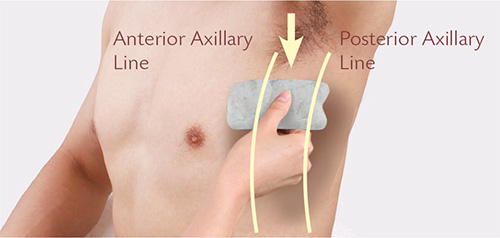

It is mainly marked by the pain of muscles and joints due to the intrusion of the pathogenic wind, cold and damp. The typical symptom is featured by mild or moderate fever, with mobile inflammation. It can occur repeatedly and becomes worse when the patient catches cold.
Scraping therapy can relax the muscles, stimulate the blood circulation, smooth main and collateral channels, while easing the pain. The recommended procedures of scraping are associated with shoulders, elbows, wrists, knees and ankles, which can be used as the case may be.
The patient of rheumatic arthritis should pay attention to avoiding catching cold, being caught in the rain or suffering from dampness, particularly keeping joints warm, avoiding wearing wet clothes, shoes and socks. During the active period of rheumatism, the patient should lie in bed for rest, avoid physical labor, and eat food rich in vitamin and low in fat and food that can be easily digested. The patient, after the activity of rheumatism is brought under control, should continue to lie in bed for 3 to 4 weeks and then begin to do physical exercise for rehabilitation, i.e., walking and jogging under the guidance of the doctor.
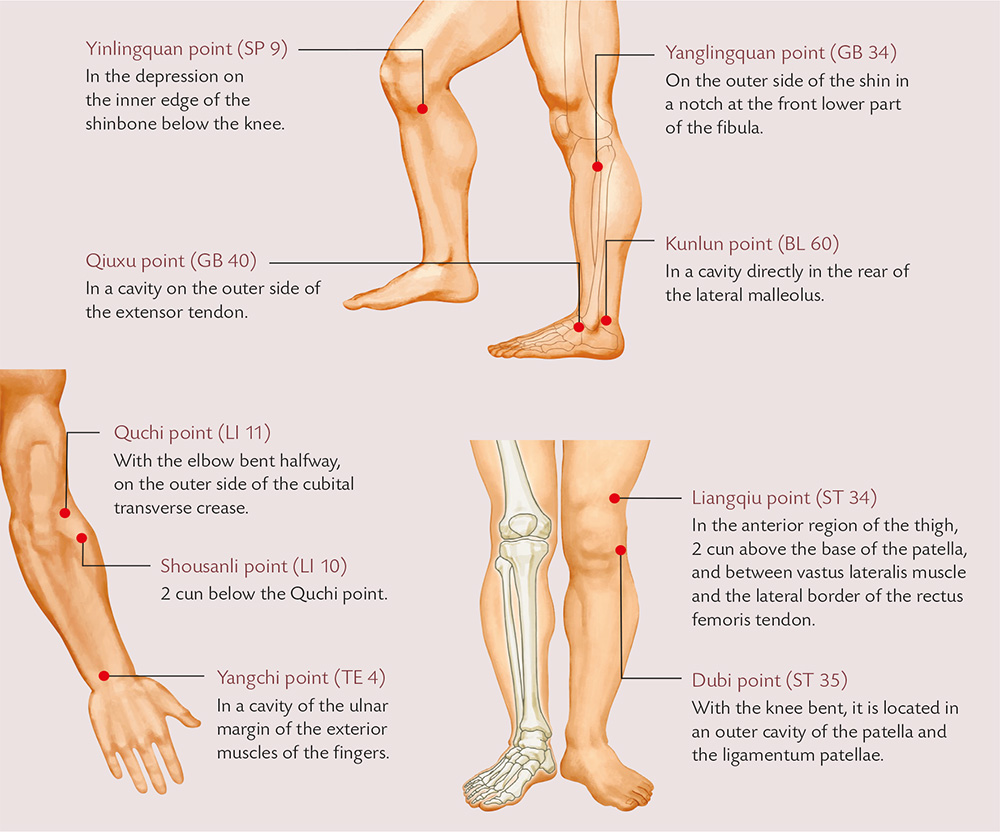
1. Scapular Area
Method: Use the surface-scraping to scrape scapular area from inside to outside, until sha appears. It is applicable to arthritis of scapular region.

2. Quchi Point, Shousanli Point and Yangchi Point
Method: Use the single-angle scraping to scrape from Quchi point to Shousanli point on the elbow of upper limbs, until sha appears. Use the angle-scraping to scrape Yangchi point on the wrist from up to down, until sha appears. It is applicable to olenitis.

3. Liangqiu Point, Dubi Point, Yanglingquan Point and Yinlingquan Point
Method: Use the single-angle scraping to scrape from Liangqiu point to Dubi point on lower limbs, until sha appears. Use the surface-scraping to scrape Yanglingquan point and Yinlingquan point, until sha appears. It is applicable to gonitis.


4. Kunlun Point and Qiuxu Point
Method: Use the single-angle scraping to scrape Kunlun point and Qiuxu point on the ankle from up to down, until sha appears. It is applicable to ankle arthritis.

Other Methods of Expelling the Cold-Damp
• Moxibustion (fig. 54)
Moxibustion is also conducive to expelling the cold-damp as well as easing joint pain. The circulation of vital energy and blood will be condensed when they are caught in the cold and dispersed when they receive warmth. Through warm and hot stimulation of main and collateral channels and acupoints, moxibustion serves to warm up main and collateral channels as well as disperse the cold and stasis to reinforce the circulation of vital energy and blood in the human body, which is particularly effective to symptoms of the cold-damp. Moxibustion can deal with various joint pains caused by blood stasis due to the intrusion of the cold and obstruction of main and collateral channels. It will be more effective if sliced ginger or sliced garlic is applied to the area of pain or the related acupoints together with moxibustion.
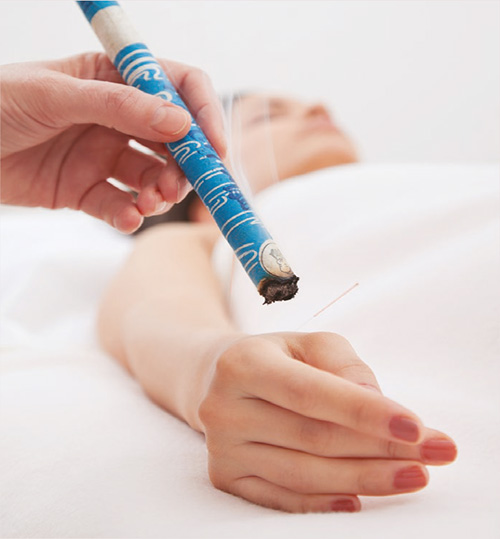
Fig. 54 Moxibustion can expel the cold and dampness.
• Cupping (fig. 55)
Cupping can dredge main and collateral channels as well as the circulation of vital energy and blood, serving to reduce distention, stop pain, adjust the balance between yin and yang, expel wind, toxin, cold and damp, which is very suitable for those suffering from joint pain due to the cold-damp. The area to be cupped is generally chosen at the place of joint pain. Cupping is generally done twice to three times a week, and once a week in winter since cupping of higher frequency will impair yang energy. Fire cupping is better than suction cupping. Cupping is not advisable if the patient is weak in yang energy or with weak physique.

Fig. 55 Cupping therapy can expel the cold and dampness.
• Appropriate Exercise (fig. 56)
Expelling sweat through doing physical exercise is a very good way to get rid of cold-damp, as it can invigorate inner organs of the human body and speed up the expulsion of dampness. In particular, do not turn on the air-conditioner and the fan so as to discharge sweat. Otherwise, too much dampness plus the intrusion of the cold is very apt to result in the pain in muscles and joints. Such physical exercises “with quick breath and sweat” of an appropriate extent as jogging, quick walk, swimming, yoga and taijiquan (a kind of Chinese traditional shadow boxing) are the best for expelling the cold-damp in the body.
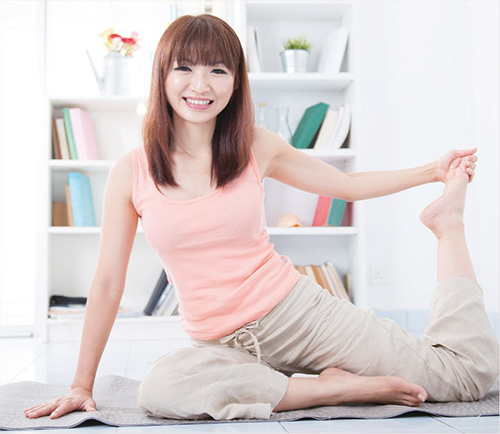
Fig. 56 Appropriate exercise with sweat can expel the cold and dampness.
It is mostly caused by partial stasis of vital energy and blood, the obstruction of channels and malnutrition of tendons and bones due to trauma and strains of elbows or the intrusion of wind, the cold and the damp. Treatment should not only target at easing the pain, but also at restoring the functions of elbow joints. Scraping therapy can expel the wind and damp, promote the flow of the vital energy and blood as well as main and collateral channels, playing an active role in easing the pain and restoring joint functions.
Apart from trauma, elbow joint pain is largely due to external humeral epicondylitis which is commonly called “tennis elbow.” This illness tends to develop slowly, being apt to be overlooked and that it will be troublesome to treat it if it lasts for a long time. Therefore, anyone with an obvious feeling of it should go to the hospital for timely examination.
Recommended Procedures
1. Zhouliao Point
Method: Use the surface-scraping to scrape Zhouliao point from up to down, until sha appears.

2. Shaohai Point
Method: Use the surface-scraping to scrape Shaohai point from up to down, until sha appears.

3. Shousanli Point
Method: Use the surface-scraping to scrape Shousanli point from up to down, until sha appears.


Therapy to Increase the Curative Effect
Before going to bed every night, pour some superior mature vinegar on a dry towel to wrap the elbow joint and wrap a layer of plastic wrap or a piece of plastic cloth to fix it. Keeping doing it for several days will ease the pain to a certain extent.
This is mostly caused by over-tiredness at work and tendon injury due to accumulated fatigue or intrusion of the cold, resulting in the stasis of vital energy and blood and failure to nurture tendons. People in modern times often use the mouse and keep the wrist in one posture for a long time, also constituting an important factor for the wrist pain. Scraping therapy can expel the cold, the damp, smooth main and collateral channels, regulate vital energy and blood, improve partial circulation, repair damaged tissues, so as to ease and cure wrist pain.
Recommended Procedures
1. Waiguan Point
Method: Use the surface-scraping to scrape Waiguan point from up to down, until the skin turns red. The appearance of sha is not necessary.

2. Yangchi Point and Yanggu Point
Method: Use the angle-scraping to scrape Yangchi point and Yanggu point from up to down, until sha appears. Or use the single-angle pressing and kneading to press and knead these two points, until soreness and distention are felt.

3. Wangu Point
Method: Use the single-angle pressing and kneading to press and knead Wangu point, until soreness and distention are felt.
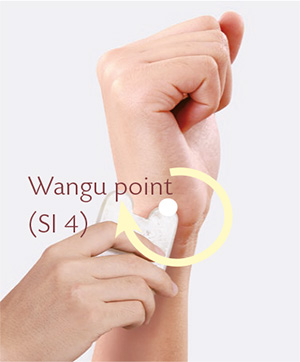

Therapy to Increase the Curative Effect
Moxibustion can be an auxiliary means of treatment if the patient feels cold and painful in the wrist, i.e., light the moxa stick and direct it at Wangu point, Yanggu point and Yangchi point for 10 minutes respectively. Then, the patient will feel warm in the wrist along with the reduction of pain. Do it once every day and the pain will be obviously eased in a week.
It is mostly caused by joint sprain. The harm to meridians in the ankle, the blockage of the vital energy and blood circulation and meridians, the energy stagnation and blood stasis after the injury will lead to partial bruising, pain and obstruction of joint movement to varying degrees.
The pain will be obvious when one walks since the ankle bears huge pressure of the human body. It cannot be overlooked even if the injury is not serious and without obvious pain, because the delay of treatment will result in a long cycle of recovery. Scraping therapy is conducive to restoring joint functions while removing blood stasis, reducing distention and stopping pain.
Don’t use massage or scraping therapy to treat ankle sprain at the beginning. The sprain should be relieved by cold compression first for 2 to 3 days, and 3 to 5 times each day. Those therapies can be exerted after the pain and distention are slightly eased. The patient with obvious distention should raise the affected limb for a rest to facilitate the reduction of swelling.
Recommended Procedures
1. Jiexi Point and Kunlun Point
Method: Use the angle-pressing and kneading to gently press and knead Jiexi point and Kunlun point.

2. The Surrounding Area of the Related Acupoints
Method: If the ankle distention is very serious or its skin is broken, making it difficult to scrape or press and knead, the operator may gently scrape the surrounding area of the related acupoints.


Knee joint pain reflects many kinds of diseases, such as rheumatic arthritis, rheumatoid arthritis, knee ligaments injuries, meniscus injury of knee joints, hyperosteogeny of knee joints and periarticular fibrositis. Rheumatism, strains, excessive movement and obesity are all major factors for causing knee joint pain. Scraping therapy can smooth main and collateral channels, vital energy and blood in the related area and ease pain.
It is not advisable to scrape the joints when the knee joint pain in impaired tissues attacks within 24 hours, nor is it advisable to scrape the affected areas in the case of serious damage to ligaments or joint swelling with fluid accumulated inside. It is acceptable to scrape acupoints at the far end or the reflection areas of knee joints on hands and feet.

1. Dubi Point and Heding Point
Method: Use the corner of the scraping plate to press Dubi point on both knees. Use the surface-scraping to scrape from the upper part of the Heding point toward the lower part of the knee.


2. Liangqiu Point, Zusanli Point, Xiyangguan Point and Yanglingquan Point
Method: Use the surface-scraping to scrape Liangqiu point on the upper part outside the knee and Zusanli point on the lower part of the knee, and then from Xiyangguan point to Yanglingquan point.

3. Xuehai Point and Yinlingquan Point
Method: Use the surface-scraping to scrape Xuehai point on the upper part on the inside of the knee and Yinlingquan point on the lower part on the inside of the knee.

4. Weizhong Point, Weiyang Point, Yin’gu Point and Chengshan Point
Method: Use the surface-scraping to scrape Weizhong point, Weiyang point, Yin’gu point and Chengshan point on the rear side of lower limbs from up to down.

Therapy to Increase the Curative Effect
Salt-ironing therapy: 500-gram salt and 120-gram fennel are fried hot together on a pan, half of which is enclosed in a piece of cloth to wrap the area of pain. The other half will be used when the first half becomes cool. The cool half can be fried again. Such salt-ironing is repeatedly applied for several days, and once every day. This can expel the wind and remove the cold, serving to deal with various kinds of joint pains caused by rheumatic arthritis while also producing a curative effect on rheumatic waist pain.
This is germ-free inflammation caused by acute or chronic damage. The heel is an important bearing point for supporting the whole body. Heel pain can be caused by bearing weight and walking for a long time, or by injury, strains and intrusion of the cold-damp into main and collateral channels. According to Chinese medicine, chronic heel pain is also associated with weak liver and kidney functions, malnutrition of muscles and bones as well as excessive strains among old people. Scraping therapy can expel stasis and obstruction of main and collateral channels or stasis of vital energy and blood, nurturing tendons, bones and muscles so as to eliminate pain.
First of all, shoes of appropriate size should be chosen to prevent and ease heel pain. In daily life, feet can be immersed in warm water or treated with hot compression. Over-tiredness, walking or standing for a long time should be avoided. It is easy for people with flatfeet to suffer from heel pain. So, they should pay more attention to excessive movement in order to avoid harm to plantar fascia and that they had better wear corrective shoes.

1. Daling Point
Method: Use the surface-scraping to scrape Daling point of Pericardium Meridian on the upper limb of the affected side from up to down.

2. Weizhong Point, Chengshan Point, Fuyang Point and Shenmai Point
Method: Use the surface-scraping to scrape from Weizhong point to Chengshan point, Fuyang point and Shenmai point of Bladder Meridian on the lower limb of the affected side from up to down.

3. Taixi Point, Shuiquan Point and Zhaohai Point
Method: Use the flat-pressing and kneading to press and knead Taixi point, Shuiquan point and Zhaohai point of the affected side on the foot.

4. Shenshu Point and Yongquan Point
Method: Use the surface-scraping to scrape Shenshu point on the back from up to down. Use the single-angle scraping to scrape Yongquan point of the affected side in the sole.

This refers to a series of symptoms marked by the distention and protrusion of the intervertebral disc from the damaged fiber rings, irritating or pressing the spinal cord and the nerve root. The symptoms are mainly featured by radiating pain or numbness in the waist and lower limbs. There will be more pain when the patient stands, walks, coughs, sneezes or forcefully discharges excrement. The pain will be reduced when the patient bends at hips or knees or rests in bed.
According to Chinese medicine, this disease is mostly associated with trauma, strains, and the intrusion of the pathogenic wind, cold, damp and heat, as well as the disharmony between ying-energy and wei-energy, harm to the vital energy and blood in main and collateral channels, or liver-kidney insufficiency. Scraping therapy can help to smooth vital energy and blood in main and collateral channels, easing the pain.
When lumbar disc protrusion is in the acute period, it is not advisable to scrape acupoints or apply other kinds of techniques around the waist, but acupoints on lower limbs can be chosen. The patient of lumbar disc protrusion is not supposed to stand or sit for a long time, nor should he/she lift heavy things or bend the waist forcefully. He/she should keep warm and avoid catching the cold while paying attention to resting in flat-board bed on his/her back.

1. Reflection Areas of the Lumbar Vertebra on the Hand Back and on Medial Foot
Method: Use the surface-scraping to scrape the areas. The operator should find the point of pain and scrape it slowly and emphatically.


2. Mingmen Point, Yaoyangguan Point, Shenshu Point, Yaoshu Point and Yaoyan Point
Method: Use the surface-scraping to scrape from Mingmen point to Yaoyangguan point from up to down. Then, use the surface-scraping to scrape from Shenshu point to Yaoshu point from up to down. Use the angle-pressing and kneading to press and knead Yaoyan point on both sides, until soreness and distention are felt.

3. Yinmen Point, Weizhong Point and Chengshan Point
Method: Use the surface-scraping to scrape Yinmen point, Weizhong point and Chengshan point from up to down.

4. Fengshi Point, Xiyangguan Point and Yanglingquan Point
Method: Use the surface-scraping to scrape from Fengshi point to Xiyangguan point from up to down. Use the angle-scraping to scrape Yanglingquan point.
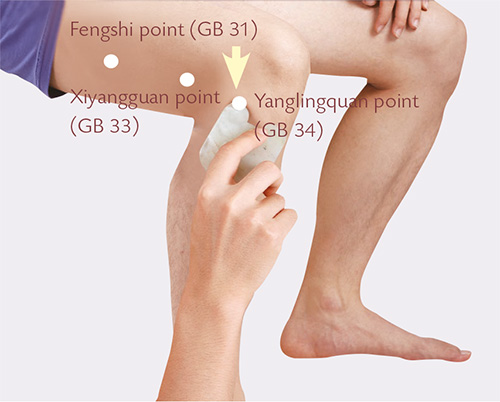
It is mainly seen among old people. Along with the aging, decline and aging of physiological functions take place. Retrogressive intervertebral disc loses fluid, the centrum is not stable, the protruding nucleus pulposus pushes up the bone membrane of the posterior longitudinal ligament and generates new bones, forming bony spurs or hyperosteogeny.
The patient with hyperosteogeny should try to avoid fierce physical exercise, but physical exercise of appropriate extent is necessary. Timely treatment is needed if joints are injured. Controlling weight is also very helpful in easing the symptom.

Recommended Procedures
1. Dazhui Point, Dazhu Point and Gaohuang Point
Method: Use the surface-scraping to scrape Dazhui point, Dazhu point and Gaohuang point from up to down, until the skin turns red or sha appears.
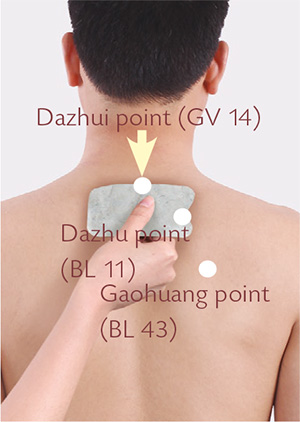
2. Chengshan Point
Method: Use the surface-scraping to scrape Chengshan point from up to down, until the skin turns red or sha appears.

3. Zhaohai Point
Method: Use the angle-scraping to scrape Zhaohai point from up to down, until the skin turns red or sha appears.

As a chronic inflammatory illness, it mainly intrudes the spine and the soft tissues beside it. In the early stage, the patient has no obvious discomfort. As the illness progresses, there will be such symptoms as pain in the waist, back, neck, buttocks and hips as well as restriction over the movement. It will be obvious at night or early in the morning and it will be eased after the movement.
In daily life, the patient of ankylosing spondylitis should pay attention to keeping proper standing and sitting postures. If feeling stiff in the spine after getting up in the morning, the patient is advised to breathe in and out deeply, expand the chest and straighten up the back to ease the symptom.

Recommended Procedures
1. Dazhui Point and Jiaji Points
Method: Use the surface-scraping to scrape Dazhui point from up to down. Use the dual-angle scraping to scrape Jiaji points from up to down, until the skin turns red or sha appears.

2. Weizhong Point and Chengshan Point
Method: Use the surface-scraping to scrape from Weizhong point to Chengshan point, until the skin turns red or sha appears.
